One example of the trend in journalistic circles to overreach when discussing Islamic extremism is that of The Washington Post’s Jim Hoagland, who casts an illustrative net so wide in his reporting of the Taliban that it catches all Muslim and Southwest Asian men, dehumanizing all instead of only a few.
Jim Hoagland’s April 12, 2009 article for The Washington Post, “The War Within Islam,” is the best example of “journalistic” Islamophobia I’ve seen in a reputable news source in quite a while. Hoagland has written for The Washington Post for several years, and his focus is on both national and international politics.
But in all his time at the Post, this is the first time he’s ever shown editorial concern for Muslim women. In fact, it’s only the second time he’s focused on Muslim women at all: in 2005, he wrote about the gains that Iraqi women gained in the 2005 elections. These two articles alone reflect a heavy-handed political paternalism that is amplified when he discusses the position of women in predominately Muslim societies. Get ready to see some serious faking concern for women as a mask and justifification for martial occupation!
On a serious note, Hoagland opens by describing the recent video of a Pakistani girl being publicly whipped. This was a horrific occurrence, and no one should be made to suffer this way, publicly or privately. But Hoagland’s use of this video to illustrate the “brutality” of the local Taliban is misplaced because he ends up casting an illustrative net so wide that it catches all Muslim and Southwest Asian men, dehumanizing all instead of only a few. Which one is worse, I’m not sure.
While Hoagland attempted to differentiate between Islam and the political entities he discusses in last Sunday’s article by using specifics (“the Taliban’s version of Islamic law”; “Fanatical Islamic sects have framed their battle in holy terms and seek to destroy their faith’s mainstream values.”), any delineation is lost in his judgment-laden words and mischaracterizations of Afghan and Pakistani men.
The casual insertion of disparaging and condemnatory phrases, such as “…the local Taliban commander continues to flog her without mercy…”, “brutal subjugation of poor, uneducated women…”, and “The savage misogyny and feudal fury of the Swat Valley…”, paints a picture of a place where men are evil and women are victims. (emphasis mine) Instead of placing the blame on local manifestations of patriarchy, he hurls blame at local Taliban, not minding that his condemnation falls like misguided bombs on innocent men who have nothing to do with the Taliban or the public whipping in Pakistan.
Even without actually using the words “brutal” or “savage,” Hoagland successfully uses language to construct Afghan and Pakistani Muslim men as both: “The recent U.S. strategic review, … depict[s] the struggle in the desolate Afghanistan-Pakistan frontier as being rooted in fierce nationalism, the region’s ancient warrior culture, the failures of nation-building and the rebirth of jihadist terrorism.” Ancient warrior culture, huh? If that doesn’t convince you that these brown guys are also the bad guys, then what of “the desire of Pakistani and Afghan men to be left in peace to deal with their womenfolk as they see fit.”? Or “The savage misogyny and feudal fury of the Swat Valley are alien to modern, urban Turkey…” ?
There’s an interesting angle. The idea that Turkey is the “good” Muslim country, and Afghanistan and Pakistan are the “bad” ones is also racialized and Islamophobic. All three countries are predominately Muslim, but because of Turkey’s political/ideological identification with the white, non-Muslim West (particularly Europe), Turkey is the “tolerant, sophisticated” country, despite the fact that Turkey has just as many failings in women’s and human rights as Afghanistan and Pakistan do, both in its history and the present day.
Hoagland also drags out that old gem about Islam being incompatible with modernity: “All religions are absorbing the shocks of globalization. But none has felt more besieged than Islam as the flow of people, goods and instant communications across borders perturb or limit its deep reach into gender relations and family structures.” This paints Islam and Muslims as if they “can’t handle” modernization, and are thus not modern. Not to mention the myopic view that misses examples of religious extremism and gender backlashes from other faiths that have also grown with the rise of globalization.
The article is simply more of the same martial voices trying to camouflage themselves as “protectors of brown women from brown men” under the guise of politics. Hoagland’s judgmental phrases that cast Afghanistan, Pakistan, and everyone within their borders as innately and decidedly good-or-evil is not journalism, and it’s astonishing to see someone who has written about the region and its politics for so long know so little.
(Photo: moderntime via flickr under a Creative Commons license)
Fatemeh Fakhraie is Associate Editor of Altmuslimah.




